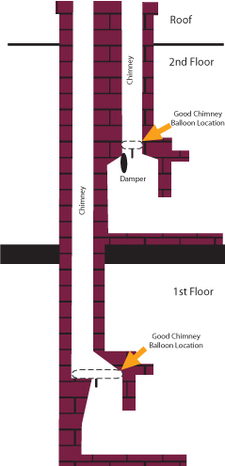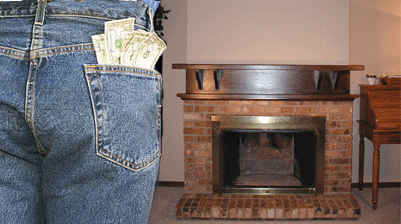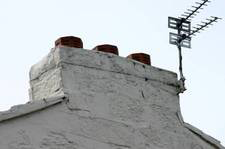
by blogediter | May 1, 2019 | Chimney Plugs
Q: Jason, We have a fireplace upstairs and one directly below it downstairs. Sometimes when we use one fireplace the other one will be smoky. Do we need more than one chimney pillow, or can we even use a chimney pillow in this situation? – LK
A: LK, When you have a fireplace that is one above another the two hearths usually have separate flues and dampers and they run to the roof in the same chimney structure. See the diagram of the two fireplaces sharing a chimney structure.
When you are using one fireplace and chimney your home is drinking in air from other places to allow enough airflow to feed the fire and to draft the smoke and heat upwards out the flue. The home will suck in air from the path of least resistance which is usually the other unused chimney (even if the damper is closed). This draw of air into the house is known as the “stack effect”.
So when the other chimney sucks in air from the roof it also sucks back in some smoke from the other fireplace chimney.
The solution to this problem is to use 2 separate Chimney Balloons, one for each flue. When you have a fire in one of the fireplaces then remove that Chimney Balloon in the used fireplace and leave the other one in place in the unused fireplace. This will force your home to find another less-smoky place to draw from, like doors or windows. – Jason

by blogediter | Feb 25, 2019 | Fireplaces
Fire Place sucksanim
On a cold winter eve who of us is not tempted to go to the living room and stoke up a fire in the fireplace and read a book in front of the fire? You may be thinking “I am doing myself a favor by supplementing the furnace with additional heat”, but in fact, you are making your house colder and could be contributing significantly to pollution depending upon how you burn.
The wood burning fireplace is a losing proposition
The air action that a wood burning fireplace initiates in our home is wasteful. The moment the damper is opened heated air begins pouring out of the top of the chimney. As the fire in the hearth accelerates, the combustion process grabs already heated air from your home and burns the oxygen and combustible gasses in it. The heat that is created in this combustion quickly rises and grabs more heated inside air and tosses it up the chimney. You can restrict the amount of inside air that the fireplace has access to by installing glass doors, but this will also severely limit the amount of radiant heat that fireplace can cast forward into your living space. This radiant heat is the heat you feel on your skin in front of the fireplace and is the only usable heat that the fireplace will produce since the combustion heat is pouring out the top of the chimney. In the meantime, the home is drawing in cold outside air from other places (i.e. windows, light sockets, doors, etc) to replace the air that is escaping the home through the chimney. This is referred to as the “stack effect”.
Loosing heat even while dormant
Even while the wood fireplace is not being used, the traditional metal dampers tend to leak air since they warp and degrade rapidly in the extreme heat and corrosive soot environment. The removable and reusable Chimney Balloon fireplace chimney damper available in assorted sizes inflates into place in the flue and seals it off efficiently to stop heat loss and the cold draft.
The good, the bad, and the pollution
If you burn a fast hot fire this creates very little smoke and pollution, and it can give you a noticeable amount of radiant heat gain in the room the fireplace it is in. However, it is using volume amounts of your already heated inside air for its combustion which exceeds your heat gain ratio. A slower fire is even worse since you are still loosing heated air out the chimney and getting very little radiant heat in return. This black type of fireplace smoke is a terrible pollutant and contributes to respiratory irritant for people with asthma and allergies.
Wood burning fireplaces are wonderful nostalgic centerpieces for many American homes. But a homeowner should be aware of the issues associated with fireplace use.
Sources:
US Department of Energy
WoodHeat.org
GreenBuildingElements.com

by blogediter | May 2, 2018 | Fireplaces
Three Chimneys
Q: Jason – I have two fireplaces in my home, one in the living room and one in the basement. When I light one fireplace the other one gets smoky. My fireplace shop said to crack a window so this wouldn’t happen, but it is -1 degrees F out, who wants to open a window when it is so cold?! Why would that help keep the smoke out? – KM
A: KM – You are experiencing a very common problem among new homes with multiple fireplaces. Let’s look at this in sections
1) Your fireplace sucks air when lit.
When you light one fireplace that fire starts drawing air from the rest of the house like a vacuum for the combustion process. To replace that air the house will start drawing in outside air through the path of least resistance in order to equalize the pressure. This is called the “stack effect”. Your home could draw this air through worn weatherstripping, power outlets on outside walls, cracks, under insulated windows, or many other ways. One of the weakest points in a homes air envelope seal is the metal fireplace damper. In you case your home is pretty tight but your fireplace damper is the path of least resistance for cold air to gain entry. See the image below of 3 chimneys that are too close together, they may draw smoke from each other.
2) Your fireplace damper is weak and is the easiest way for cold outside air to gain entrance.
When the air is drawn down the chimney to equalize the pressure in your home it also draws down the smoke that is wafting around your roof. This is why your basement gets smoky.
3) Seal your basement damper.
If you seal up the basement damper and flue with a Chimney Balloon it will then be air tight and will not draw in smoke.
4) Your home cannot be a vacuum.
When you burn in your fireplace your home will continue to draw in air from the outside. It just wont be drawing smoky air from your roof. But it will draw from somewhere. That is why burning in your fireplace does not save you on heat, it actually costs you heat in most situations.


